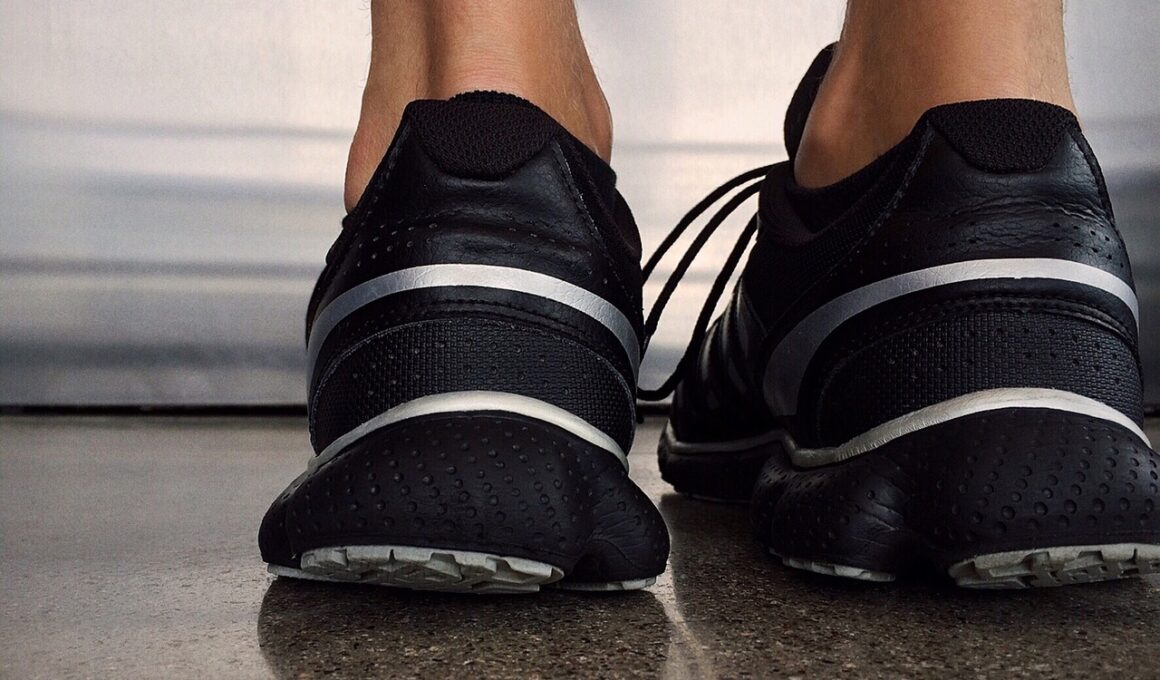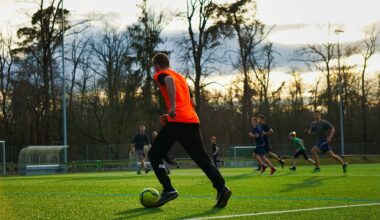Developing Foot Strength to Enhance Running Stability
Foot strength is vital for runners aiming to improve their balance and coordination. The feet endure considerable stress during running, making them crucial for stabilization. Runners benefit from exercises targeting foot muscles, which enhance strength and flexibility. Such exercises can lead to improved overall performance and can reduce the risk of injuries. From plantar flexors to intrinsic foot muscles, each contributes to a runner’s ability to maintain balance during dynamic movements. Integrating foot-strengthening workouts into a training regimen can significantly impact running efficiency. It is essential to assess one’s foot health and strength regularly. Runners should prioritize foot care to maintain optimal foot condition; in turn, this leads to more enjoyable running experiences. This attention to foot fitness supports proper biomechanics and reduces stress on the lower limbs. Many athletes overlook their feet and focus solely on their legs and core, missing out on an essential component of stability. Incorporating balance-focused activities, such as yoga, also proves beneficial in enhancing overall foot strength and coordination. By targeting the feet specifically with tailored exercises, runners can achieve lasting benefits in their running endeavors, making sustained foot strength a priority.
Strengthening the muscles in the feet contributes significantly to better performance. It is common for runners to underestimate the value of foot strength. Implementing foot exercises into the training routine can lead to noticeable improvements. Simple exercises like toe curls, calf raises, and resistance band work can foster better stability. One excellent approach includes incorporating a variety of movements that challenge the foot’s musculature. As a runner engages in these exercises consistently, the feet adapt and grow stronger, facilitating greater balance during runs. Enhanced foot strength directly correlates with reduced incidence of common running injuries, such as shin splints and plantar fasciitis. Additionally, exercises that incorporate single-leg balances challenge not only foot strength but also overall core stability. This combination is crucial for a runner’s form during training and competition. Envision frequent assessments of foot health that highlight the need for strengthening practices. Furthermore, runners must understand the importance of proper footwear to support training efforts in gaining strength. The right shoes can alleviate undue stress on the feet and improve performance. Ultimately, the runner must develop a comprehensive foot strength routine to reap the benefits of improved balance and coordination.
Exercises for Foot Strength
Many effective exercises exist to promote foot strength for runners. These exercises are designed to target the various muscles in the foot and lower leg. Toe curls can be performed by curling the toes around a towel laid on the floor, thus engaging the muscles. Additionally, calf raises, done by lifting the heels while standing, build strength in the calves, which contributes to ankle stability. Foot doming is another great exercise; it consists of raising the arch of the foot while keeping the heel and toes grounded. These exercises, when performed consistently, result in building endurance and strength in the foot muscles. Bands can also be incorporated, providing resistance during movements to further enhance strength gains. Further, utilizing balance boards can aid in engaging intrinsic foot muscles while working on coordination. The key is to diversify the exercises to target all aspects of foot strength. Runners may also consider incorporating agility drills that mimic running dynamics while focusing on foot strength. As foot strength increases, runners are likely to experience improvements in their overall balance during running, leading to enhanced performance on various surfaces.
Maintaining a balanced training program is essential for improving foot strength for runners. Runners should also focus on flexibility and mobility to complement strength training. Stretching the calf muscles, Achilles tendon, and plantar fascia helps to prevent tightness. Tight muscles can contribute to instability while running, reducing balance. Regular stretching routines can alleviate discomfort and enhance range of motion. Additionally, integrating proprioceptive exercises into a training regimen can further contribute to improved balance. Training the body to sense its position informs the brain about necessary adjustments while running. Furthermore, incorporating varied terrains into running sessions enhances coordination and strengthens foot musculature. Different surfaces require unique adaptations, challenging the feet in new ways. Working with a coach or physical therapist may provide personalized advice for individual foot strength needs. Understanding personal weaknesses is helpful for developing an effective training plan. Engaging in group activities can also boost motivation and accountability in improving foot strength. Lastly, it is essential to listen to the body during training, recognizing signs of fatigue or pain. This strategy ensures resilience in the foot, nurturing stability and balance as runners strive for their personal best.
The Role of Proper Footwear
Footwear plays a critical role in building foot strength and enhancing running stability. Proper shoes support the foot correctly, aiding overall biomechanics during runs. Runners often overlook the importance of choosing the right shoe type, which is essential for their training and racing performance. Shoes that fit well provide adequate cushioning and arch support, reducing the risk of injury. The types of shoes may vary from stability running shoes to neutral options, depending on the runner’s biomechanics and foot shape. Custom orthotics or insoles may also be a viable option for runners needing support tailored to their specific foot conditions. Additionally, shoes designed for different terrains can offer improved traction, reducing slips that affect balance. Runners should never underestimate the effects of fatigue on the feet caused by inadequate footwear. Ensuring shoes are regularly replaced based on wear and tear is vital for optimal foot function. Ultimately, proper footwear is part of a comprehensive approach to enhancing foot strength while supporting stability. Exploring recommendations from fellow runners, trainers, and specialists helps refine one’s choices in footwear, ultimately fostering improved running experiences.
Nutrition and hydration also contribute significantly to a runner’s foot strength and overall performance. Runners must maintain proper nutrient intake to support muscle development, including foot musculature. A diet rich in calcium, magnesium, and vitamin D is essential for bone health. Additionally, proteins play a crucial role in muscle repair and growth, aiding in recovery from intense training. Dehydration can cause muscle cramps and diminish balance, making hydration essential for maintaining muscle function. Runners should consume enough fluids before, during, and after exercises to support optimal performance. Implementing a balanced diet alongside foot-strengthening workouts can significantly enhance running stability. Regularly fueling the body with wholesome foods ensures muscular endurance and reduces injury risk. Furthermore, understanding energy needs tailored to individual training loads can optimize performance. Whole grains, fruits, vegetables, and lean proteins should form the basis of a runner’s nutrition plan. Consider working with a sports nutritionist for personalized advice. Overall, integrating solid nutrition with foot-strengthening exercises supports runners in their pursuit of balance, ensuring they can perform at their best during every run.
Monitoring Progress and Adjustments
Monitoring progress in foot strength development should be an ongoing process for any runner. Regular assessments can help highlight improvements, as well as areas needing attention. Keeping a training log detailing exercises, distances, and responses aids this monitoring process. This practice can provide insights into strengths and weaknesses over time. Evaluating one’s performance can also showcase how foot strength impacts overall balance while running. Runners should always be open to adjustments in their routines. If specific exercises feel stagnant, find alternatives that can provide better engagement. This adaptability fosters growth and keeps the training regimen fresh and exciting. Additionally, incorporating feedback from coaches, trainers, or physical therapists can enhance the pursuit of establishing effective strategies for improvement. Setting short and long-term goals provides further motivation and direction. Progress can be monitored through specific metrics like reduced injury rates or improved performance times. Frequent evaluation allows for necessary changes, ensuring a targeted approach in continuing foot strength development. These consistent, committed efforts lead to improved stability and balance while running, ultimately contributing to a more enjoyable, successful running experience.
Developing foot strength requires patience and commitment, yet the rewards are substantial for dedicated runners. By enhancing foot muscles and promoting coordination, running stability improves significantly. Through the incorporation of targeted exercises, proper footwear, nutrition, and hydration, runners can harness the full potential of their feet. Remaining adaptable and observant in their training process empowers runners to continue growing and achieving their goals. With consistent focus on foot strength, runners can enjoy longer, injury-free experiences while reaching new heights in performance. Therefore, the commitment to developing foot strength is a worthy investment, providing sustained benefits in balance and coordination. Ultimately, the collective focus on this often-neglected aspect of training can lead to improved overall athleticism in runners. By valuing foot strength and coordinating the various aspects of training, runners can foster longevity in their passion for the sport. Continuous engagement with foot health supports greater enjoyment during running. In doing so, they exemplify the dedication necessary to excel in every stride they take. This journey towards enhancing foot strength provides invaluable insights not only in running but also in overall biomechanics and physical well-being.


